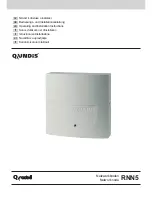
49
Cisco Systems, Inc.
www.cisco.com
Configuring Switch Alarms
Information About Switch Alarms
The switch software monitors switch conditions on a per-port or a switch basis. If the conditions present on the switch
or a port do not match the set parameters, the switch software triggers an alarm or a system message. By default, the
switch software sends the system messages to a system message logging facility, or a
syslog
facility. You can also
configure the switch to send Simple Network Management Protocol (SNMP) traps to an SNMP server.
Global Status Monitoring Alarms
The switch processes alarms related to temperature and power supply conditions, referred to as global or facility alarms.
FCS Error Hysteresis Threshold
The Ethernet standard calls for a maximum bit-error rate of 10
-8
. The bit error-rate range is from 10
-6
to 10
-11
. The bit
error-rate input to the switch is a positive exponent. If you want to configure the bit error-rate of 10
-9
, enter the value 9
for the exponent. By default, the FCS bit error-rate is 10
-8
.
You can set the FCS error hysteresis threshold to prevent the toggle of the alarm when the actual bit-error rate fluctuates
near the configured rate. The hysteresis threshold is defined as the ratio between the alarm clear threshold to the alarm
set threshold, expressed as a percentage value.
For example, if the FCS bit error-rate alarm value is configured to 10
–8
, that value is the alarm set threshold. To set the
alarm clear threshold at 5*10
-10
, the hysteresis, value
h
, is determined as follows:
Table 10
Global Status Monitoring Alarms
Alarm
Description
Power supply alarm
The switch monitors dual power supply levels. If there are two power supplies installed in the
switch, an alarm triggers if a power supply fails. The alarm is automatically cleared when both
power supplies are working. You can configure the power supply alarm to be connected to the
hardware relays.
For more information, see
Configuring the Power Supply Alarms, page 51
.
Temperature alarms
The switch contains one temperature sensor with a primary and secondary temperature setting.
The sensor monitors the environmental conditions inside the switch.
The primary and secondary temperature alarms can be set as follows:
The primary alarm is enabled automatically to trigger both at a low temperature, –4°F (–20°C)
and a high temperature, 203°F (95°C). It cannot be disabled. By default, the primary
temperature alarm is associated with the major relay.
The secondary alarm triggers when the system temperature is higher or lower than the
configured high and low temperature thresholds. The secondary alarm is disabled by default.
For more information, see
Configuring the Switch Temperature Alarms, page 52
.
SD-Card
By default the alarm is disabled.
Summary of Contents for IE 4000
Page 12: ...8 Configuration Overview Default Settings After Initial Switch Configuration ...
Page 52: ...48 Configuring Interfaces Monitoring and Maintaining the Interfaces ...
Page 108: ...104 Configuring Switch Clusters Additional References ...
Page 128: ...124 Performing Switch Administration Additional References ...
Page 130: ...126 Configuring PTP ...
Page 140: ...136 Configuring CIP Additional References ...
Page 146: ...142 Configuring SDM Templates Configuration Examples for Configuring SDM Templates ...
Page 192: ...188 Configuring Switch Based Authentication Additional References ...
Page 244: ...240 Configuring IEEE 802 1x Port Based Authentication Additional References ...
Page 298: ...294 Configuring VLANs Additional References ...
Page 336: ...332 Configuring STP Additional References ...
Page 408: ...404 Configuring DHCP Additional References ...
Page 450: ...446 Configuring IGMP Snooping and MVR Additional References ...
Page 490: ...486 Configuring SPAN and RSPAN Additional References ...
Page 502: ...498 Configuring Layer 2 NAT ...
Page 770: ...766 Configuring IPv6 MLD Snooping Related Documents ...
Page 930: ...926 Configuring IP Unicast Routing Related Documents ...
Page 976: ...972 Configuring Cisco IOS IP SLAs Operations Additional References ...
Page 978: ...974 Dying Gasp ...
Page 990: ...986 Configuring Enhanced Object Tracking Monitoring Enhanced Object Tracking ...
Page 994: ...990 Configuring MODBUS TCP Displaying MODBUS TCP Information ...
Page 996: ...992 Ethernet CFM ...
Page 1066: ...1062 Using an SD Card SD Card Alarms ...
















































